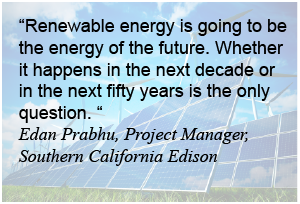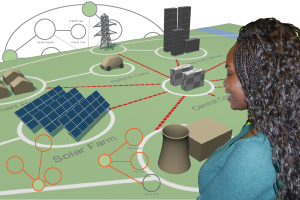|
 Putting the world on a path toward renewable energy will require both brilliant new ideas and also careful re-engineering of existing technologies. Physics underlies all aspects of renewable energy, from the invention of new types of solar cells to schemes for beaming microwave energy to Earth from orbiting solar power satellites. There are many exciting careers in these fields awaiting you. The examples below should provide you a start for researching the connection between physics and your future career.
Putting the world on a path toward renewable energy will require both brilliant new ideas and also careful re-engineering of existing technologies. Physics underlies all aspects of renewable energy, from the invention of new types of solar cells to schemes for beaming microwave energy to Earth from orbiting solar power satellites. There are many exciting careers in these fields awaiting you. The examples below should provide you a start for researching the connection between physics and your future career. 
|
The ebb and flow of the tides release daily more than five times the total energy consumption of the human race. Environmental engineers are working on ways to convert some of this energy to useful electricity. Tidal power devices have to withstand harsh weather, the ceaseless beating of waves, and the corrosive effects of salt water. Demonstration power plants are working in several areas of the world, but more ideas and better technologies are still needed. 
|
 The rate at which wind and solar sources produce electricity goes up and down constantly and depends upon weather and season. Demand for electricity also goes up and down. How do we build and manage the complex network needed to match ever-changing power capacity to an ever-changing demand? Design of a world-spanning smart power grid is an enormously complex task awaiting tomorrow’s electrical engineers.
The rate at which wind and solar sources produce electricity goes up and down constantly and depends upon weather and season. Demand for electricity also goes up and down. How do we build and manage the complex network needed to match ever-changing power capacity to an ever-changing demand? Design of a world-spanning smart power grid is an enormously complex task awaiting tomorrow’s electrical engineers. 
|
 Photovoltaic cells use the photoelectric effect to transform sunlight into electric current. The process, however, is only 14% efficient and very expensive. Are there better ways to convert sunlight into electricity? Engineers and materials scientists are working toward building a synthetic “leaf” that uses a nanotechnology form of photosynthesis.
Photovoltaic cells use the photoelectric effect to transform sunlight into electric current. The process, however, is only 14% efficient and very expensive. Are there better ways to convert sunlight into electricity? Engineers and materials scientists are working toward building a synthetic “leaf” that uses a nanotechnology form of photosynthesis. 
|
 Architects can design structures that heat, cool, and light themselves with a minimum of fuel or electricity. How? By channeling sunlight, breezes, and geothermal energy into interior spaces that are insulated against sudden temperature changes. Thermodynamics, optics, and fluid dynamics all support this increasingly valued specialty.
Architects can design structures that heat, cool, and light themselves with a minimum of fuel or electricity. How? By channeling sunlight, breezes, and geothermal energy into interior spaces that are insulated against sudden temperature changes. Thermodynamics, optics, and fluid dynamics all support this increasingly valued specialty. 
|
Explain how physics might be relevant to the practice of energy-efficient building design.
 |
To reduce a building’s use of fuel or electricity, an architect needs to understand how different materials retain or transmit heat (thermodynamics), how sunlight can be used to light indoor spaces (optics), how prevailing winds can be tapped for energy generation or passive cooling (fluid dynamics), and many other applications of the physics of energy. 
|

